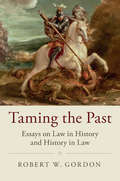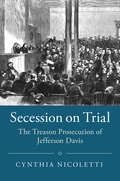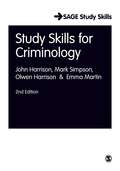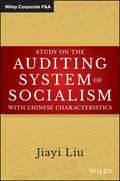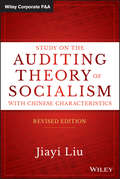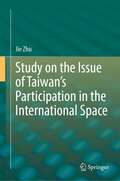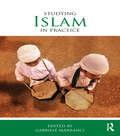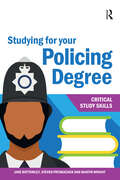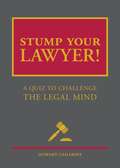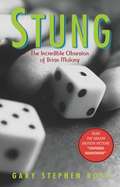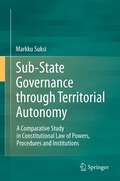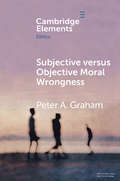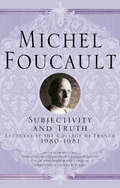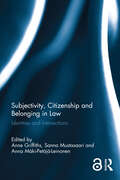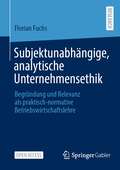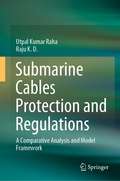- Table View
- List View
Studies in Legal History: Criminal Law in Liberal and Fascist Italy
by Paul GarfinkelBy extending the chronological parameters of existing scholarship, and by focusing on legal experts' overriding and enduring concern with 'dangerous' forms of common crime, this study offers a major reinterpretation of criminal-law reform and legal culture in Italy from the Liberal (1861-1922) to the Fascist era (1922-43). Garfinkel argues that scholars have long overstated the influence of positivist criminology on Italian legal culture and that the kingdom's penal-reform movement was driven not by the radical criminological theories of Cesare Lombroso, but instead by a growing body of statistics and legal researches that related rising rates of crime to the instability of the Italian state. Drawing on a vast array of archival, legal and official sources, the author explains the sustained and wide-ranging interest in penal-law reform that defined this era in Italian legal history while analyzing the philosophical underpinnings of that reform and its relationship to contemporary penal-reform movements abroad.
Studies in Legal History: Essays on Law in History and History in Law (Studies in Legal History)
by Gordon Robert W.Lawyers and judges often make arguments based on history - on the authority of precedent and original constitutional understandings. They argue both to preserve the inspirational, heroic past and to discard its darker pieces - such as feudalism and slavery, the tyranny of princes and priests, and the subordination of women. In doing so, lawyers tame the unruly, ugly, embarrassing elements of the past, smoothing them into reassuring tales of progress. In a series of essays and lectures written over forty years, Robert W. Gordon describes and analyses how lawyers approach the past and the strategies they use to recruit history for present use while erasing or keeping at bay its threatening or inconvenient aspects. Together, the corpus of work featured in Taming the Past offers an analysis of American law and society and its leading historians since 1900.
Studies in Legal History: Fractional Freedoms
by Mckinley Michelle A.Fractional Freedoms explores how thousands of slaves in colonial Peru were able to secure their freedom, keep their families intact, negotiate lower self-purchase prices, and arrange transfers of ownership by filing legal claims. Through extensive archival research, Michelle A. McKinley excavates the experiences of enslaved women whose historical footprint is barely visible in the official record. She complicates the way we think about life under slavery and demonstrates the degree to which slaves were able to exercise their own agency, despite being ensnared by the Atlantic slave trade. Enslaved women are situated as legal actors who had overlapping identities as wives, mothers, mistresses, wet-nurses and day-wage domestics, and these experiences within the urban working environment are shown to condition their identities as slaves. Although the outcomes of their lawsuits varied, Fractional Freedoms demonstrates how enslaved women used channels of affection and intimacy to press for liberty and prevent the generational transmission of enslavement to their children.
Studies in Legal History: The Old English Penitentials and Anglo-Saxon Law
by Stefan JurasinskiSome of the earliest examples of medieval canon law are penitentials - texts enumerating the sins a confessor might encounter among laypeople or other clergy and suggesting means of reconciliation. Often they gave advice on matters of secular law as well, offering judgments on the proper way to contract a marriage or on the treatment of slaves. This book argues that their importance to more general legal-historical questions, long suspected by historians but rarely explored, is most evident in an important (and often misunderstood) subgroup of the penitentials: composed in Old English. Though based on Latin sources - principally those attributed to Theodore, Archbishop of Canterbury (d. 690) and Halitgar of Cambrai (d. 831) - these texts recast them into new ordinances meant to better suit the needs of English laypeople. The Old English penitentials thus witness to how one early medieval polity established a tradition of written vernacular law.
Studies in Legal History: The Treason Prosecution of Jefferson Davis (Studies in Legal History)
by Cynthia NicolettiThis book focuses on the post-Civil War treason prosecution of Confederate President Jefferson Davis, which was seen as a test case on the major question that animated the Civil War: the constitutionality of secession. The case never went to trial because it threatened to undercut the meaning and significance of Union victory. Cynthia Nicoletti describes the interactions of the lawyers who worked on both sides of the Davis case - who saw its potential to disrupt the verdict of the battlefield against secession. In the aftermath of the Civil War, Americans engaged in a wide-ranging debate over the legitimacy and effectiveness of war as a method of legal adjudication. Instead of risking the 'wrong' outcome in the highly volatile Davis case, the Supreme Court took the opportunity to pronounce secession unconstitutional in Texas v. White (1869).
Studies in Legal History: Women and Justice for the Poor
by Felice BatlanThis book re-examines fundamental assumptions about the American legal profession and the boundaries between 'professional' lawyers, 'lay' lawyers, and social workers. Putting legal history and women's history in dialogue, it demonstrates that nineteenth-century women's organizations first offered legal aid to the poor and that middle-class women functioning as lay lawyers, provided such assistance. Felice Batlan illustrates that by the early twentieth century, male lawyers founded their own legal aid societies. These new legal aid lawyers created an imagined history of legal aid and a blueprint for its future in which women played no role and their accomplishments were intentionally omitted. In response, women social workers offered harsh criticisms of legal aid leaders and developed a more robust social work model of legal aid. These different models produced conflicting understandings of expertise, professionalism, the rule of law, and ultimately, the meaning of justice for the poor.
Studies on International Courts and Tribunals: The Legitimacy of International Criminal Tribunals
by Joanna Nobuo Hayashi Bailliet Cecilia M. Nicholson Cecilia M. Joanna NicholsonWith the ad hoc tribunals completing their mandates and the International Criminal Court under significant pressure, today's international criminal jurisdictions are at a critical juncture. Their legitimacy cannot be taken for granted. This multidisciplinary volume investigates key issues pertaining to legitimacy: criminal accountability, normative development, truth-discovery, complementarity, regionalism, and judicial cooperation. The volume sheds new light on previously unexplored areas, including the significance of redacted judgements, prosecutors' opening statements, rehabilitative processes of international convicts, victim expectations, court financing, and NGO activism. The book's original contributions will appeal to researchers, practitioners, advocates, and students of international criminal justice, accountability for war crimes and the rule of law.
Studio Craft & Technique for Architects Second Edition
by Anne Gorman Miriam DelaneyThis one-stop handbook for architecture students provides step-by-step techniques for perfecting the vital skills of drawing, model making and surveying. It is a primer on the conventions of architectural representation and the use of materials. It also explains the primary elements of construction and structure from first principles, using clear diagrams and drawings. Recommended in the first year at numerous architecture schools, this second edition has been updated to include a new section on sustainability, more on types of drawing and when to use them, and more on structural principles and materials.
Studio Craft & Technique for Architects Second Edition
by Anne Gorman Miriam DelaneyThis one-stop handbook for architecture students provides step-by-step techniques for perfecting the vital skills of drawing, model making and surveying. It is a primer on the conventions of architectural representation and the use of materials. It also explains the primary elements of construction and structure from first principles, using clear diagrams and drawings. Recommended in the first year at numerous architecture schools, this second edition has been updated to include a new section on sustainability, more on types of drawing and when to use them, and more on structural principles and materials.
Study Skills for Criminology (SAGE Study Skills Series)
by Dr Mark Simpson Olwen Harrison Mr John Harrison Ms Emma MartinThe new edition of this best-selling study skills book provides a practical guide for success for individuals at every level of their criminology and criminal justice degree. The new edition of this best-selling study skills book is a practical guide to success for individuals at every level of their criminology and criminal justice degree. Fully revised to reflect changes in the curriculum, the book continues to provide students with practical and relevant information for their degree, including topics on choosing modules, sourcing and researching, applying theory to practice, writing essays, presentation skills, revision, taking exams and careers after your degree. New to the second edition: o a chapter on plagiarism o developments in virtual learning environments and e-resources o expanded coverage of internet and e-learning skills o advice on moving from A-level to university. Maintaining its student-friendly approach and useful pedagogy - tips, activities, glossary, key terms and issues - Study Skills for Criminology is an essential purchase for any student of criminology or criminal justice looking to excel in their degree. SAGE Study Skills are essential study guides for students of all levels. From how to write great essays and succeeding at university, to writing your undergraduate dissertation and doing postgraduate research, SAGE Study Skills help you get the best from your time at university.John Harrison, formerly of Teesside University. Mark Simpson is Dean of the School of Social Sciences and Law at Teesside University. Olwen Harrison, formerly of Teesside University. Emma Martin is Senior Lecturer in Criminology at Teesside University.
Study on the Auditing System of Socialism with Chinese Characteristics
by Jiayi LiuA comprehensive, authoritative examination of Chinese auditing practices Study on the Auditing System of Socialism with Chinese Characteristics provides unprecedented insight into China's current audit process, with expert contributions and predictions of future trends. Author Jiayi Liu is the Auditor General of the National Audit Office of the People's Republic of China, and the current chairman of the governing boards of the International Organizations of Supreme Audit Institutions; in this book, he draws upon his vast experience to help you better understand China's unique approach to auditing. Contributions from senior auditors across the China National Audit Office share deep insight into the system's framework, features, and development, providing a comprehensive, systematic examination of current, past, and future practices. As a leading global auditing authority, Liu is the ideal source of information and clarity on China's auditing system. This book opens up the practices, processes, and foundational aspects of this complex system to provide insight for those doing business in China. Understand the foundation of the Chinese auditing system Learn how the system was created and developed over time Delve into the system's framework and detailed features Gain first-hand insight into China's auditing experience Developed as a companion to Study on the Auditing Theory of Socialism with Chinese Characteristics, this book expands upon the system's basic foundations to show how theory translates into practice. Companies who do business in China need a working knowledge of the system, and a scientific examination from the definitive authority provides a level of insight you won't find anywhere else. Study on the Auditing System of Socialism with Chinese Characteristics is the essential primer to the Chinese audit.
Study on the Auditing Theory of Socialism with Chinese Characteristics, Revised Edition
by Jiayi LiuA comprehensive guide to China's public, private, and internal audit system Study on the Auditing Theory of Socialism with Chinese Characteristics provides a comprehensive overview of China's auditing practices. Recent years have seen the National Audit Office of China (CNAO) making remarkable headway not only in China by guaranteeing the healthy operation of the economy and society and improving national governance through government auditing, but also in the international arena by carrying out audits with the United Nations. With constant development in the practice, an audit theory with socialist Chinese characteristics has taken shape, centering on the premise that government auditing serves as the cornerstone and safeguard of national governance. At the XXI INCOSAI held in 2013 in Beijing, the theme of "national audit and national governance" proposed and chaired by CNAO, was met with widespread approval by participants from over 160 countries, and led to the endorsement of the Beijing Declaration, which makes it a priority and target for audit institutions to promote good national governance. To explore the nature and development of government auditing, this book probes into the history and reality, and theories and practices of auditing in various countries, and puts forward the assertion that, "as a cornerstone and important safeguard for national governance, government auditing is an 'immune system' endogenous within the synthetical system of national governance, with functions of precaution, revelation and defense." Furthermore, China's socialist auditing theory has been elaborated in nine aspects, nature, functions, goals, features, methods, management, framework of regulations and standards, IT application and culture, covering the new concepts, methodologies, techniques and achievements of China's government auditing. This book is highly relevant, practical, and readable. Jiayi Liu, the chief author, is the Auditor General of China and the current Chairman of INTOSAI Governing Board. In 2013 he won the United Nations Peace Prize in recognition of his auditing work for UN peacekeeping operations.
Study on the Issue of Taiwan’s Participation in the International Space
by Jie ZhuThis book points out the legal roots of the alignment of Cross-Strait political relations and the issues of Taiwan's participation in international space, and the Treaty of San Francisco and the “Undetermined Status of Taiwan”. Based on an academic standpoint, the book studies the legal theories related to the alignment of Cross-Strait political relations and the issues of Taiwan's participation in international space from the Mainland Chinese perspective. It focuses on the different descriptions and regulations of the alignment of Cross-Strait political relations between the Mainland of China and Taiwan and discusses the status, forms, problems, and prospects of the coexistence of the two sides in the international space. Compared with the policy oaths used in current studies, the book systematically discusses the alignment of Cross-Strait political relations and the issues of Taiwan's participation in international space with a theoretical interpretation. It uses detailed historical materials, especially valuable policy documents and excerpts of speeches cited of the Mainland of China. This book puts forward a series of important propositions, such as the construction of a mechanism for Taiwan’s orderly participation in the international space and means of existence of the Taiwan region in the international space.
Studying Islam in Practice (Studying Religions in Practice)
by Gabriele MarranciThis book presents Islam as a lived religion through observation and discussion of how Muslims from a variety of countries, traditions and views practice their religion. It conveys the experiences of researchers from different disciplinary backgrounds and demonstrates the dynamic and heterogeneous world of Islam. The fascinating case studies range from Turkey, Egypt, Morocco and Lebanon to the UK, USA, Australia and Indonesia, and cover topics such as music, art, education, law, gender and sexuality. Together they will help students understand how research into religious practice is carried out, and what issues and challenges arise.
Studying for your Policing Degree (Critical Study Skills)
by Martin Wright Jane Bottomley Steven PryjmachukStudying for your Policing Degree is PERFECT for anyone wanting to train to become a police officer. After reading this fully comprehensive guide you will understand: the structure and culture of HE, and how policing fits into it what to expect, and what will be expected of you, as a university student teaching and assessment methods within policing, so that you can perform to the best of your ability in an academic environment how to manage your policing studies in an effective way and make the most of the resources available to you. The books in our Critical Study Skills series will help you gain the knowledge, skills and strategies you need to achieve your goals. They provide support in all areas important for university study, including institutional and disciplinary policy and practice, self-management, and research and communication. Packed with tasks and activities to help you improve your learning, including learner autonomy and critical thinking, and to guide you towards reflective practice in your study and work life. Uniquely, this book is written by a subject specialist and an English for Academic Purposes (EAP) expert.
Stump Your Lawyer
by Howard ZaharoffFor the lawyers who think they know it all&mdas;lor for those of you who worry that your legal counsel can't tell a tort from a tartStump Your Lawyer! is a hilarious tour of the quirks and curiosities of our legal system. This tongue-in-cheek volume offers witty, practical, and thought-provoking challenges for the legally minded. Short case histories, definitions, multiple-choice quizzes, and other formats mock the bar exam approach and probe the reader's knowledge of obscure statutes, baffling decisions, bizarre legal concepts, and antiquated jargon. Whether you're studying, practicing, or running from the law, this book will keep you laughing--and learning--all the way to the courthouse.
Stung: The Incredible Obsession of Brian Molony
by Gary Stephen RossHe was one of the brightest stars at the Canadian Imperial Bank of Commerce, a brilliant young banker on his way to the top. But Brian Molony had a secret obsession: he loved to gamble. The unsuspecting bank was soon fueling that obsession, as Molony helped himself to hundreds of thousands, then millions, of dollars in fraudulent loans. Despite falling deeper and deeper in the hole, Molony convinced himself he could win it all back. Before long, the mild-mannered assistant manager had become one of the biggest high-rollers the casinos had ever seen and earned himself a place in the annals of criminal history.
Sub-Patent Innovation Rights: Utility Models, Petty Patents and Innovation Patents Around the World
by Jorge L. ContrerasThis ground-breaking work delves into the world of sub-patent intellectual property rights, exploring utility model and similar protection offered by over 100 countries worldwide. Drawing on the expertise of leading scholars from around the globe, this volume provides a comprehensive analysis of sub-patent protection systems, comparing and contrasting statutory frameworks, registration requirements, corporate strategies and litigation tactics. The book also highlights current policy debates surrounding these systems, including their potential to promote local innovation and economic development, proposals for cross-border harmonization, and their interaction with increasingly integrated litigation systems. This book is an invaluable resource for scholars, attorneys, historians, economists, and anyone dealing with complex international intellectual property matters. This title is also available as Open Access on Cambridge Core.
Sub-State Governance through Territorial Autonomy
by Markku SuksiThis study focuses on territorial autonomy, which is often used in different conflict-resolution and minority situations. Four typical elements are identified on the basis of the historical example of the Memel Territory and the so-called Memel case of the PCIJ; distribution of powers, participation through elections and referendums, executive power of territorial autonomy, and international relations. These elements are used for a comparative analysis of the constitutional law that regulates the position of six currently existing special jurisdictions, the Åland Islands in Finalnd, Scotland in the United Kingdom, Puerto Rico in the United States of America, Hong Kong in China, Aceh in Indonesia and Zanzibar in Tanzania. The current sub-state entities examined can be arranged in relation to Memel in a manner that indicates that Hong Kong and the Åland conform to the typical territorial autonomy, while Puerto Rico and Aceh should probably not be understood as territorial autonomies proper. At the same time, the territorial autonomies can be distinguished from federally organized sub-state entities.
Subjective versus Objective Moral Wrongness (Elements in Ethics)
by Peter A. GrahamThere is presently a debate between Subjectivists and Objectivists about moral wrongness. Subjectivism is the view that the moral status of our actions, whether they are morally wrong or not, is grounded in our subjective circumstances – either our beliefs about, or our evidence concerning, the world around us. Objectivism, on the other hand, is the view that the moral status of our actions is grounded in our objective circumstances – all those facts other than those which comprise our subjective circumstances. A third view, Ecumenism, has it that the moral status of our actions is grounded both in our subjective and our objective circumstances. After outlining and evaluating the various arguments both against Subjectivism and against Objectivism, this Element offers a tentative defense of Objectivism about moral wrongness.
Subjectivity and Truth: Lectures at the Collège de France, 1980-1981
by Michel Foucault“The working hypothesis is this: it is true that sexuality as experience is obviously not independent of codes and systems of prohibitions, but it needs to be recalled straightaway that these codes are astonishingly stable, continuous, and slow to change. It needs to be recalled also that the way in which they are observed or transgressed also seems to be very stable and very repetitive. On the other hand, the point of historical mobility, what no doubt change most often, what are most fragile, are modalities of experience.” - Michel Foucault In 1981 Foucault delivered a course of lectures which marked a decisive reorientation in his thought and of the project of a History of Sexuality outlined in 1976. It was in these lectures that arts of living became the focal point around which he developed a new way of thinking about subjectivity. It was also the moment when Foucault problematized a conception of ethics understood as the patient elaboration of a relationship of self to self. It was the study of the sexual experience of the Ancients that made these new conceptual developments possible. Within this framework, Foucault examined medical writings, tracts on marriage, the philosophy of love, or the prognostic value of erotic dreams, for evidence of a structuration of the subject in his relationship to pleasures (aphrodisia) which is prior to the modern construction of a science of sexuality as well as to the Christian fearful obsession with the flesh. What was actually at stake was establishing that the imposition of a scrupulous and interminable hermeneutics of desire was the invention of Christianity. But to do this it was necessary to establish the irreducible specificity of ancient techniques of self. In these lectures, which clearly foreshadow The Use of Pleasures and The Care of Self, Foucault examines the Greek subordination of gender differences to the primacy of an opposition between active and passive, as well as the development by Imperial stoicism of a model of the conjugal bond which advocates unwavering fidelity and shared feelings and which leads to the disqualification of homosexuality.
Subjectivity, Citizenship and Belonging in Law: Identities and Intersections
by Anne Griffiths Sanna Mustasaari Anna Mäki-Petajä-LeinonenThis collection of articles critically examines legal subjectivity and ideas of citizenship inherent in legal thought. The chapters offer a novel perspective on current debates in this area by exploring the connections between public and political issues as they intersect with more intimate sets of relations and private identities. Covering issues as diverse as autonomy, vulnerability and care, family and work, immigration control, the institution of speech, and the electorate and the right to vote, they provide a broader canvas upon which to comprehend more complex notions of citizenship, personhood, identity and belonging in law, in their various ramifications.
Subjectivity, Citizenship and Belonging in Law: Identities and Intersections
by Anne Griffiths Sanna Mustasaari Anna Mäki-Petäjä-LeinonenThis collection of articles critically examines legal subjectivity and ideas of citizenship inherent in legal thought. The chapters offer a novel perspective on current debates in this area by exploring the connections between public and political issues as they intersect with more intimate sets of relations and private identities. Covering issues as diverse as autonomy, vulnerability and care, family and work, immigration control, the institution of speech, and the electorate and the right to vote, they provide a broader canvas upon which to comprehend more complex notions of citizenship, personhood, identity and belonging in law, in their various ramifications.Chapter 7 of this book is freely available as a downloadable Open Access PDF at http://www.taylorfrancis.com under a Creative Commons Attribution-Non Commercial-No Derivatives (CC-BY-NC-ND) 4.0 license.
Subjektunabhängige, analytische Unternehmensethik: Begründung und Relevanz als praktisch-normative Betriebswirtschaftslehre
by Florian FuchsIn diesem Open-Access-Buch beleuchtet Florian Fuchs den historischen Diskurs um eine Integration ethischer Fragestellungen in die betriebswirtschaftliche Forschung. Vor dem Hintergrund einer bisher fehlenden originären Mesoethik entwickelt er mit einem Rekurs auf die Erkenntnisse der neueren Systemtheorie eine neue Unternehmensethikkonzeption. Diese ermöglicht erstmalig die Konzeption einer genuinen Unternehmensethik als strukturiertes Legitimitätsmanagement. Seit der Begründung der Betriebswirtschaftslehre Ende des 19. Jahrhunderts wird um die Sinnhaftigkeit und Möglichkeit einer fundierten Beschäftigung mit normativen Aussagen im Allgemeinen, sowie einer Forschungstätigkeit in der Domäne der Wirtschaftsethik im Speziellen, intensiv wie kontrovers gerungen. Dabei bleibt vor dem Hintergrund zahlreicher Unternehmensskandale und einer zunehmenden gesellschaftlichen Kritik an der Wirtschaftspraxis eine kritische Reflexion wirtschaftlichen Handelns hochrelevant – wobei allerdings die Frage zu stellen ist, wie eine wirtschaftsethische Beschäftigung für die BWL wissenschaftshistorisch informiert wie auch wissenschaftstheoretisch fundiert zu begründen wäre.
Submarine Cables Protection and Regulations: A Comparative Analysis and Model Framework
by Utpal Kumar Raha Raju K. D.This book highlights the critical importance of laying, quick relinking, and protecting submarine cables with timely approval for carriers and cable repairing ships and how these are most challenging in many jurisdictions. It identifies that a dedicated national instrument on submarine cable as a way forward is yet to be appreciated by many States, and presently, there is no model legal framework for national instruments on submarine cables available. To bridge these gaps, the book undertakes a systematic inquiry and analysis of submarine cable regimes' and relevant authorities. It consults existing knowledge on international law on cables and analyzes specific principles and provisions on laying repair and maintenance of submarine cables and states’ obligations towards protecting cables from vulnerabilities. It touches upon cable regulation in the deep sea concerning the International Seabed Authority and proposed biodiversity agreement. It indicates suitable measures on cable laying, etc., and security risks in the marine space beyond the national jurisdictions. To map States’ response, it explores the domestic cable regimes, including both the selected jurisdictions and Australia and New Zealand, analyses specific legal provisions and institutional set-up, and demonstrates state practices, approaches, and loopholes in the governance of the cable system within national jurisdictions. The book suggests adopting the spatial ocean management approach, dedicated regulatory authority, a competent enforcement agency, strict liability with exemplary punishment on cable damage, and the cable system to strengthen the cable system's management. Finally, it arranges the fundamental premises of a common minimum framework for national instruments seeking coastal states’ deliberations in implementing initiatives towards a robust law and policy for reliability, resiliency, and security of the cable system. The cable industries, pipeline, fishing, shipping industries, academicians, government authorities, international bodies, and the maritime community worldwide are looking at the issues and challenges of submarine cable regimes, particularly national regimes and suggestive remedial measures. These stakeholders will find the book a useful reference.

